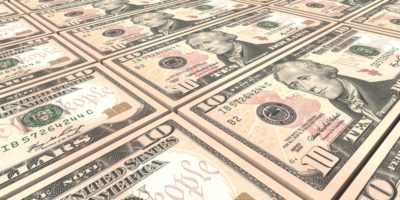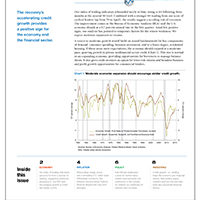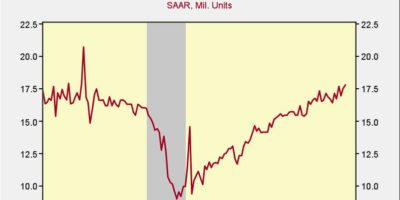
A strong November Employment Report plus upward revisions to the blowout October report suggest the economy has good momentum in the always-important fourth quarter.
READ MORE
Strong holiday spending could be a gift to the economy Overview The Economy… Steady improvements in consumer fundamentals combined with still-solid consumer expectations provide a positive outlook for holiday spending, which can make or break retailer earnings. The strength of fourth-quarter consumer spending is likely to play a critical role in sustaining overall economic growth. However, our Leaders index fell back to a neutral 50 in the latest reading, adding a note of caution to the outlook. Despite that decline, our cyclical score remains solidly positive, suggesting a relatively low risk of recession ahead. …Inflation… The CPI fell this month, the second back-to-back monthly decline this year. The latest AIER inflation Scorecard points to further downward pressure on inflation for the months ahead. Only seven out of 23 Scorecard indicators support rising inflationary pressure, while 14 suggest falling pressure. The decliners reflect many forces: demand and supply, money, banking and credit, and costs and productivity. …Policy… The Federal Reserve held off raising short-term interest rates at its October meeting. Yet, its follow-up public statement indicated that consideration of a hike will be on the table at the next meeting in December. Markets expect an increase, but some disappointing economic data have left room for doubt. Congress adopted a budget bill that resolves immediate budget challenges. These include suspending the debt limit and setting parameters for government spending through September 2017. The measure also saves the Social Security disability program from collapse and limits for many Medicare participants an increase in Part B premiums that would have been the largest in history. But long-term fiscal challenges remain. …Investing Investors are favoring stocks over bonds as the prospect of interest rate increases tempers the outlook for returns on fixed-income securities. While the plunge in crude oil prices has begun to affect U.S. production, current rates of refining and high gasoline inventory levels are still helping to push pump prices lower. Retail stocks have been strong performers throughout the current cycle, and our economic outlook suggests continued support for fundamentals, but valuations may raise concerns. New cash inflows into equities are tilted heavily toward foreign markets. Reallocation by both strategic (passive) and tactical (active) investors may be a primary cause.
READ MORE
A blowout October Employment Report suggests the economy has regained momentum just in time for the holiday shopping season. Strong numbers across the board in the report sharply raises the likelihood of a Fed rate increase in December. However, one report does not necessarily mean the economy has moved to a significantly stronger growth trend. Growth is still likely to be moderate by historical standards, implying occasional periods of mixed economic reports may occur at times. These periods of mixed data will likely prompt the Fed to remain cautious during the process of policy normalization, implementing future rate hikes only at a very gradual pace.
READ MOREToday’s first release of third quarter GDP shows real GDP grew just 1.5 percent. However, the details of the report suggest a more positive tone.
READ MORE
Boomers may brake economic growth as they head into retirement. Overview The Economy… Unusual demographic shifts currently underway and slated to last for many more years may be affecting the overall economic growth rate as well as creating pockets of relative strength and weakness. One example is in housing, where multifamily construction has rebounded more robustly than single-family homebuilding following the housing boom and subsequent bust that helped usher in the Great Recession. Our Leaders index improved slightly in the latest reading, while cyclical scores changed little. Taken together, the AIER data suggest that the risk of recession in the coming six to 12 months remains low. …Inflation… The Consumer Price Index slipped month-to-month for the first time since February 2015. This is consistent with last month’s report that inflationary pressure was easing. The latest AIER inflationary Pressures Scorecard points to further downward pressure on inflation for months to come. Only eight indicators out of 23 show rising inflationary pressure, compared with 12 last month. The easing resulted from a recent slowdown in consumer demand and fast growth in supply. A decline in energy prices was another important contributor. …Policy… The Fed kept interest rates unchanged at its September meeting, in line with market expectations. But the central bank’s projections continue to indicate that the first rate hike in more than nine years is likely to occur by the end of December. After holding rates near historic lows for so long, anticipation of the initial step toward normalization in monetary policy may actually stimulate borrowing in the short run as people try to get ahead of future increases. Demographic change is slowing growth in the labor force and gains in educational attainment. The fastest way to reverse this—skill-based immigration—is unlikely to garner political support in Washington. Alternative but slower solutions include making it easier for American youth to continue their education beyond high school. …Investing Yields on mortgage-backed securities are about in line with their historical relationship to U.S. Treasurys. An improving economy and healthier finances for borrowers would boost overall loan quality and help narrow yield spreads slightly. However, the prospect of Fed interest rate increases is likely to boost pressure on yields across the fixed-income spectrum. Lumber futures prices have fallen more than other housing-market indicators would suggest. A bubble in stock prices of U.S. homebuilders from 2000 through 2005 was worse than the better-known tech-stock bubble of the late 1990s. Following the bust in homebuilder shares and the Great Recession, homebuilder stocks since 2011 have slightly outperformed the broader market. Global equity markets have struggled in recent months, reeling from a worldwide economic slowdown, the effects of potentially higher U.S. interest rates, a strong U.S. dollar, and ongoing military conflicts that have created arefugee crisis. For those with a high tolerance for risk, these times can create opportunity.
READ MORE
The broadly disappointing September Employment Report continues the recent trend of mixed economic reports but overall suggests the economy continues to grow at a slow to moderate pace.
READ MORE
While China’s slowdown raises concerns about global growth, risks to the U.S. economy are muted. Overview The Economy… Headwinds from China’s slowing growth and a devalued yuan may curb the U.S. expansion, but the risk of a recession remains low. Our Leaders index remained solidly above 50 percent in the latest month, suggesting the probability of a domestic slump is still low. …Inflation… The CPI, compared with a year earlier, continued to advance for a second straight month in July, but future inflationary pressure has eased. In the latest AIER inflation scorecard, 12 indicators support rising inflationary pressure, compared with 17 in the last month’s report, and eight point to falling inflationary pressure, compared with just three last month. The pullback mainly came from a stronger U.S. dollar pushing down import prices and from improving business productivity. Going forward, should the Fed tighten credit by raising key interest rates, it would amplify downward pressures on prices. …Policy… Fed policy makers have long telegraphed their intention to raise short-term rates from near zero this year, but recent market turmoil may have raised fresh concerns about the timing of the first increase in almost a decade. The focus now turns to the mid-September meeting and whether the Fed will use the occasion to begin the normalization process and what policy makers might reveal about the central bank’s future plans. The recent sharp fall in oil prices, driven both by China’s slowdown and rising U.S. crude output, is creating pressure to lift the long-standing U.S. crude export ban. Proponents say ending the policy would raise U.S. prices, stimulating investment, spurring domestic production, and cutting gasoline prices. In July, the U.S. Senate Energy Committee passed a bill to lift the export ban. Whether the measure will pass Congress and how the Obama administration may react if it does remains uncertain, but an end to the 40-year-old policy may be closer than ever. …Investing Slowing growth in China coupled with a devalued yuan and improving U.S. consumer demand all suggest a widening trade gap with China. That, in turn, may lead China to buy more U.S. Treasury securities, helping to restrain gains in long-term yields just as Fed tightening approaches. Commodities are still struggling with no short-term relief in sight. But over the medium term, better global growth and a stable dollar combined with the deep price declines that have already occurred suggest that there may be light for raw materials at the end of a long tunnel. U.S. equities are still getting fundamental support from profit growth. Risks from rising labor costs and higher interest expense may threaten profit margins, but productivity may be the magic bullet that facilitates profit growth and higher wages that can, in turn, boost future spending. Global equities have been volatile and U.S. investors gave mixed signals with their new investment dollars ahead of the worst declines in Chinese markets. New cash would help support markets, while additional withdrawals from global market mutual funds and ETFs would hurt. Fed tightening remains on the horizon as a potential new source of volatility, especially for emerging markets.
READ MORE
The Fed will no doubt be looking carefully at data for August, including the upcoming Employment Situation report, for signs that recent turmoil in the global economy and capital markets may be affecting U.S. consumer or business behavior. Judging by strong auto sales and the continued low level of layoffs, it would appear that the U.S. is weathering the late summer storm reasonably well.
READ MORE
Today’s Gross Domestic Product report shows a stronger rebound for the U.S. economy in the second quarter, but no major shifts in the recent trends.
READ MORE
As the recovery enters its seventh year, revised data reveal slower progress than previously estimated. Overview The Economy… While the latest data confirmed our reading at the start of the year that economic weakness was temporary, and despite accelerating growth in the second quarter, the more complete and detailed information released last month show that the recovery since 2012 has been slower than previously reported. Today’s GDP value is almost one percentage point lower than earlier estimates led us to believe. This means the current business-cycle expansion, whether measured by output or employment growth, has been the slowest in U.S. postwar history. …Inflation… Strong CPI growth in June underlined AIER’s analysis last month pointing to rising inflationary pressures. The latest scorecard shows that 17 out of 23 indicators support rising inflationary pressure, compared with 15 in our previous report, indicating a higher likelihood of future price increases. Anticipated policy firming on interest rates may moderate rising inflationary pressures. …Policy… Fed policy makers did not provide any new signals on the timing of an increase in short-term interest rates following their July meeting. and despite the weaknesses highlighted in the revised report, the Fed continues to indicate that its policy remains on track for a liftoff this year. …Investing With still-modest growth and inflation, bond yields remain very low. However, a slowly improving U.S. economy and declining unemployment may support the Fed’s first rate hike in almost a decade. That, in turn, may pressure bond yields higher, but the question of how high yields may rise remains open. Weak global growth and a strong dollar have sent most commodity prices tumbling to multi-year lows. Add to that a price war in crude oil and the decline in demand for gold as a haven and the environment for commodities remains unfavorable. Equities around the world have done reasonably well this year—valuations are rising in many markets. Critical to continued price gains will be better economic growth helping drive future earnings.
READ MORE
The broad gains in the July Employment Report from the Labor Department this morning suggests the economy continues to grow at a moderate pace. We continue to expect the economy to post faster growth in the second half of 2015 following the weak first quarter.
READ MORE
Data released today by the U.S. Department of Commerce show second quarter real Gross Domestic Product grew 2.3 percent following an upwardly revised first quarter gain of 0.6 percent. Along with today’s first estimate of second quarter GDP, Commerce also released revised estimates of GDP for the past three years.
READ MORE250 Division Street | PO Box 1000
Great Barrington, MA 01230-1000
Press and other media outlets contact
888-528-1216
press@aier.org
This work is licensed under a
Creative Commons Attribution 4.0 International License,
except where copyright is otherwise reserved.
© 2021 American Institute for Economic Research
Privacy Policy
AIER is a 501(c)(3) Nonprofit
registered in the US under EIN: 04-2121305